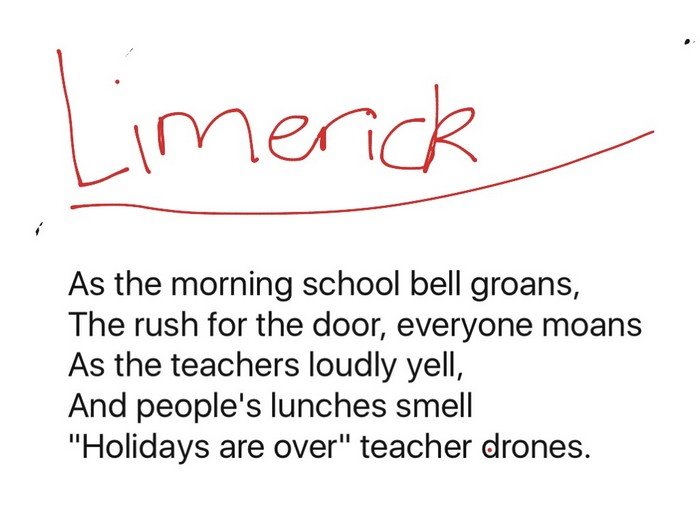Limericks are a form of humorous poetry characterized by their five-line structure and AABBA rhyme scheme. They often feature playful and sometimes bawdy themes, making them a popular choice for light-hearted entertainment. But where did limericks originate, and what is the oldest known limerick? In this article, we delve into the history of limericks, tracing their roots and exploring some early examples of this beloved poetic form.
Origins of the Limerick
The exact origins of the limerick are somewhat murky, with various theories about how this distinctive form of verse came to be. One theory suggests that limericks evolved from a type of humorous song sung by soldiers in the 18th century. These songs, known as “barrack-room ballads,” often featured ribald lyrics and a simple, repetitive structure that may have influenced the development of the limerick.
Another theory points to the city of Limerick in Ireland as the birthplace of the limerick. According to this theory, the form became popularized in the 19th century, particularly among Irish poets and writers who enjoyed crafting witty and amusing verses.
The Oldest Known Limerick
While pinpointing the absolute oldest limerick is challenging due to the informal nature of early limericks and the lack of precise historical records, there are several contenders for the title of the oldest known limerick. One of these contenders is the following verse, attributed to the English poet and playwright Edward Lear:
There was an Old Man with a nose,
Who said, ‘If you choose to suppose,
That my nose is too long,
You are certainly wrong!’
That remarkable Man with a nose.
This limerick showcases many of the hallmarks of the form, including the five-line structure, the AABBA rhyme scheme, and the playful tone. Edward Lear is widely recognized as one of the pioneers of the limerick form, having popularized it in his famous collection of nonsense poetry, “A Book of Nonsense,” published in 1846.
Early Examples of Limericks
In addition to Edward Lear’s contributions, there are other early examples of limericks that have contributed to the development and popularity of the form. One such example is a limerick from an anonymous source that dates back to the early 18th century:
There was a young rustic named Mallory,
Who drew but a very small salary.
When he went to the show,
His purse made him go
To a seat in the uppermost gallery.
This limerick demonstrates the form’s ability to convey humor through concise storytelling and clever wordplay. It also highlights the limerick’s accessibility, as it was often used by both professional poets and amateur writers to entertain and amuse.
Popularity and Evolution
Over time, limericks gained popularity as a form of entertainment in various social settings. They were often shared orally among friends and acquaintances, passed down through generations as a form of folk poetry. The accessibility and humor of limericks contributed to their widespread appeal, leading to their inclusion in newspapers, magazines, and anthologies.
As limericks became more established as a literary form, poets began to experiment with themes, styles, and structures within the five-line framework. Some limericks maintained a light-hearted and comedic tone, while others delved into satire, social commentary, or even political critique.
Modern Limericks and Cultural Impact
In the modern era, limericks continue to be a popular form of poetry, cherished for their wit, brevity, and ability to evoke laughter. They are often used in humorous greeting cards, children’s literature, and online communities dedicated to sharing and creating limericks.
The cultural impact of limericks can be seen in their influence on popular culture, including music, film, and television. Many comedians and humorists incorporate limericks into their routines, adding to the form’s enduring legacy as a source of amusement and creativity.
Conclusion
While the exact origins of the limerick may remain shrouded in mystery, its enduring popularity and evolution as a form of humorous poetry are undeniable. From early anonymous verses to the witty creations of poets like Edward Lear, limericks have entertained and delighted readers for centuries. Whether shared among friends or enjoyed in a public setting, the limerick’s unique blend of humor and structure continues to make it a beloved and enduring form of literary expression.
FAQs:
Can a limerick have 2 stanzas?
Traditionally, a limerick consists of a single stanza with five lines. Each line has a specific number of syllables and follows an AABBA rhyme scheme. However, there can be variations where a limerick has two stanzas. In such cases, each stanza typically follows the 8-8-5-5-8 syllable pattern and maintains the AABBA rhyme scheme. This structure allows for a more extended narrative or a play on words across two distinct sections while still retaining the essence of a limerick.
Can a limerick have 11 syllables?
A standard limerick typically follows a syllable pattern of 8-8-5-5-8, where the first, second, and fifth lines have 8 syllables each, and the third and fourth lines have 5 syllables each. However, variations are possible, and it’s not uncommon to find limericks with 11 syllables in certain lines. These variations can add a unique twist to the limerick’s rhythm and structure, as long as they maintain the overall light-hearted and humorous tone characteristic of limericks.
Can limericks be longer?
While the traditional form of a limerick consists of a single stanza with five lines, limericks can indeed be longer. Writers and poets often experiment with limerick-like structures that extend beyond the standard five lines. These extended limericks may include additional stanzas, allowing for more complex narratives, character development, or thematic exploration. However, it’s essential to maintain the core elements of a limerick, such as the AABBA rhyme scheme and the playful, witty tone, even in longer versions, to ensure they retain their limerick identity.

